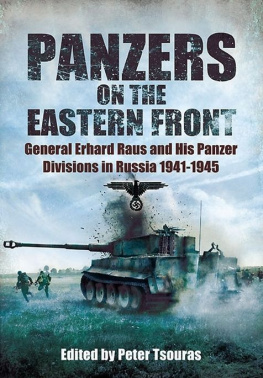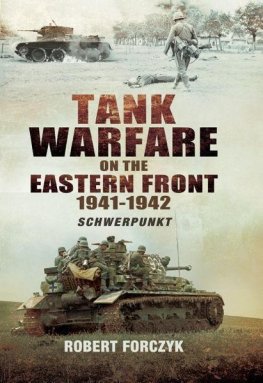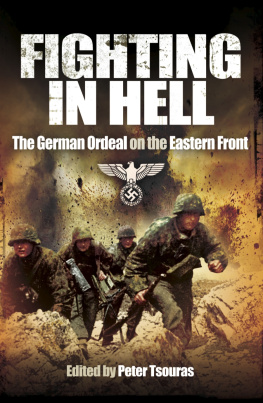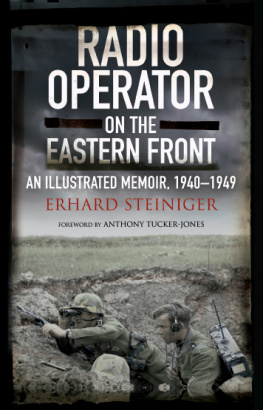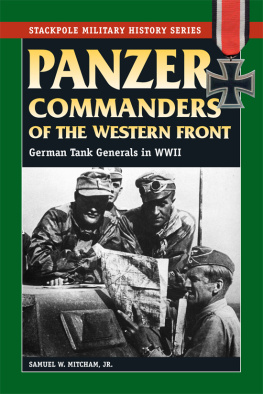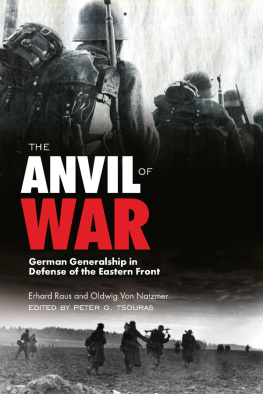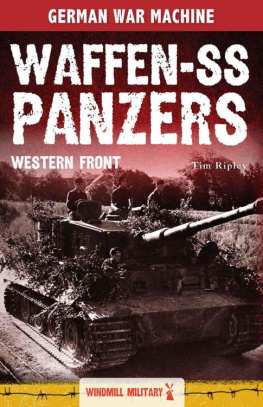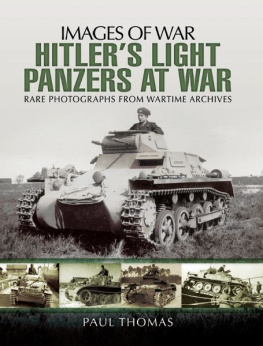WORLD WAR II GERMAN DEBRIEFS
PUBLISHED BY GREENHILL BOOKS
THE BATTLE OF THE BULGE: THE GERMAN VIEW
Perspectives from Hitlers High Command
FIGHTING IN HELL
The German Ordeal on the Eastern Front
FIGHTING IN NORMANDY
The German Army from D-Day to Villers-Bocage
FIGHTING THE INVASION
The German Army at D-Day
HITLERS ARDENNES OFFENSIVE
The German View of the Battle of the Bulge
INSIDE THE AFRIKA KORPS
The Crusader Battles, 19411942
THE LUFTWAFFE FIGHTER FORCE
The View from the Cockpit
For Captain Lincoln D. Leibner, US Army,
who showed at the Pentagon on 11 September 2001
that we still have men of courage among us.
Panzers on the Eastern Front:
General Erhard Raus and his Panzer Divisions in Russia, 19411945
First published 2002 by Greenhill Books,
Lionel Leventhal Limited, Park House, 1 Russell Gardens,
London NW11 9NN
and
Stackpole Books, 5067 Ritter Road, Mechanicsburg, PA 17055, USA
Lionel Leventhal Limited, 2002
All rights reserved. No part of this publication may be reproduced,
stored in a retrieval system or transmitted in any form or by any
means, electronic, mechanical or otherwise, without the written
permission of the Publisher.
British Library Cataloguing in Publication Data
Panzers on the Eastern Front: General Erhard Raus and his panzer
divisions in Russia, 19411945
1. Raus, Erhard 2. Germany. Heer. Panzer-Division, 6 3. World
War, 19391945 Campaigns Eastern Front
I. Title II. Tsouras, Peter
940.54217
9781783031665
Library of Congress Cataloging-in-Publication Data available
Designed and typeset by Roger Chesneau
Printed and bound in Great Britain by MPG Books Ltd,
Victoria Square, Bodmin, Cornwall
Note: The maps on page 48, 52, 55, 76, 78 and 82 are reproduced from original and surviving maps held in the US National Archives.
Preface
by Franz Halder
Chief of the German Army General Staff, 19381942
Retired General E. Rauss portrayals of extraordinary personal experiences during the Russian campaign are both exciting and instructive. The authors tactical lessons after the description of each event are to the point. Besides the studys teaching value explained in the topic leaders preliminary remarks to individual examples, its psychological value deserves to be emphasized. It becomes very clear that a strong military leader with great power of motivation is the most important factor for success.
Generaloberst (ret.) Franz Halder
Introduction
The new main-attack army, which had been detached from the troops besieging Stalingrad and had been reinforced by reserves from the eastern bank of the Volga River, assembled in the northern hills and in the valley east of Bolshaya-Vasilevka for an all-out attack against the 6th Panzer Division. Thousands of Russians filled the snowfields, slopes, and depressions of the endless steppe. No soldier had ever seen such multitudes advance on him. Their leading waves were thrown to the ground by a hail of high-explosive shells, but more and more waves followed. Any attempt on the part of the Russian masses to reach the German lines was thwarted by the fire of machine guns and guns. The frontal attack was blocked.
A few hours later, however, the Russians poured into the village from the east like a stream of lava, pushing the flank of the 4th Panzergrenadier Regiment back some 100 meters. A short time later, they pushed through the gap to the 23rd Panzer Division and rolled forward toward the rear of the troops in the bridgehead. The eastern part of the village and the vicinity of the cemetery were lost. But the division stood unshaken like a rock in the surging sea. It was only when the encirclement of the division seemed on the point of becoming complete that the Russian masses were mowed down by a sudden thunderous concentration of the German artillery and were at the same time caught in the flank by 150 tanks coming from the village, and in the rear by 42 assault guns. As a result, they were overwhelmed. Even the strongest nerves of the enemy were unequal to this eruption of fire and steel. The Russians threw their weapons away and tried like madmen to escape the infernal crossfire and the deadly armored envelopment. This was a thing which rarely happened in World War II. In mobs of several hundreds, shelled even by their own artillery and their own rocket launchers, they ran west toward the only open spot and surrendered to the German covering parties stationed there.
Generaloberst Erhard Raus
To Liberate Stalingrad, November 1952
I first came across writings of Generaloberst Erhard Raus in early 1971 while serving as a young armor officer with the United States Army in Germany. Published as Department of the Army pamphlets, they had lain untouched in my company commanders office for ages, it seemed, from all the dust I disturbed when I pulled them out of the bookcase. Being something of a Germanophile at the time, I was fascinated by these little gems of history. As I read on, it was obvious that the distilled experiences of German generals on the Russian Front were of such immediacy to our present missionthe victors of Stalingrad, the 8th Guards Army, were just 40 kilometers east of usthat I wondered why they were so little known. After all, the Soviet Armed Forces were in the full flood of expansion, preparing for the great Theater Strategic Operation (TSO) meant to carry them to the Channel and the Pyrenees.
I was also struck by the anonymity of the authors of these pamphlets. The Army had given a brief rsum, but also added the statement that the author wished to remain anonymous. It was only years later, when I found the bible behind the pamphlets at the Army Library in the Pentagonthe Guide to Foreign Military Studiesthat I was able to unravel this mystery. This was the story of the US Armys program to capture the experience of the senior German officers (see Appendix 2 for the story of the Foreign Studies Program). Now I knew the name of the authorErhard Rausbut, in all my reading of Eastern Front operations, the name had not stuck in my memory. Who was he? Who was this man who had so many dramatic and breathtaking stories at his fingertips?
The more I looked, the more impressed I became with one of the great unsung commanders of the twentieth centurya man who led the spearhead of the relief force that drove for the trapped Sixth Army in Stalingrad, the man who had commanded the brilliant defense in the Fourth Battle of Kharkov, the man who had led three panzer armies with distinction, and the man who was such a master of the art of war and leadership that his men coined a phrase for the saving effects of those qualities: Raus zieht heraus ! (Raus pulls you through!). For a long time, the pantheon of German commanders on the Eastern Front was a murky thing at best for the Western audience. Those commanders who had fought against the Western Allies were well knownfor example, Rommel and Kesselring. We had heard of Eastern Front commanders who had also gained reputations in the WestGuderian, von Manstein, von Mellenthin and von Manteuffeland their reptuations rested not a little on the books they were able to write. But Raus wrote no book and passed away quietly in 1956.

